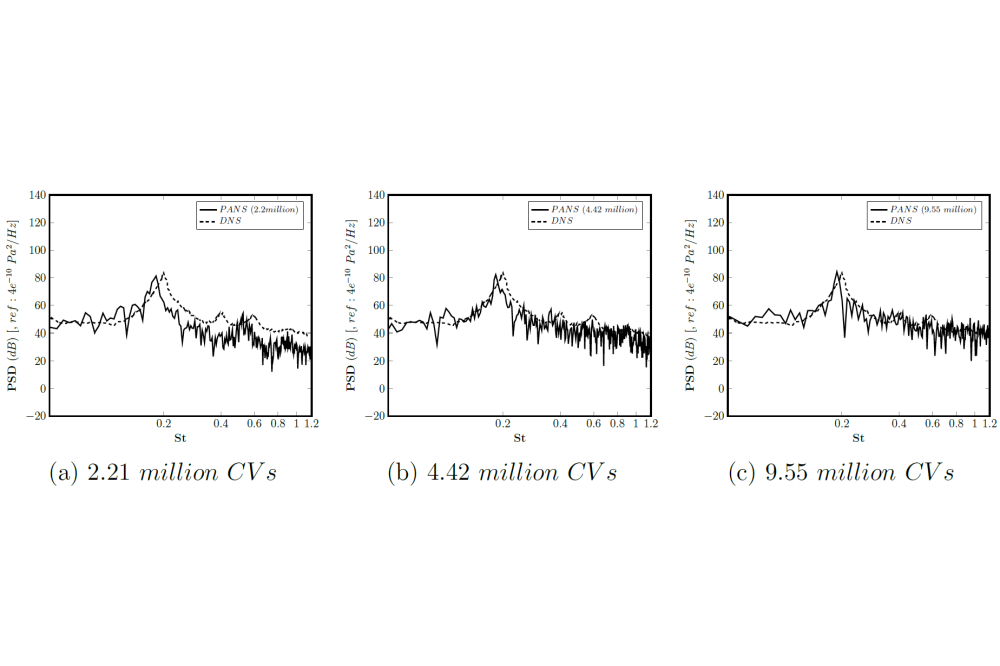Aeroacoustics Simulation using Partially-Averaged-Navier-Stokes Model
Introduction
Aeroacoustics studies the creation and spread of sound from unsteady flow with solid structures. Computational Aeroacoustics (CAA) has become popular due to its accuracy, speed, and cost-effectiveness. The PANS method is a widely used CAA method that accurately captures unsteady flow features while keeping computational costs low. A novel PANS method, the SSV-PANS method, has been developed, which includes a modeled equation for computing the resolved kinetic energy, resulting in significant improvements in computational efficiency for turbulent flow simulations. This research evaluates the SSV-PANS method’s performance in predicting aeroacoustics for two benchmark test cases: a cylinder and an Ahmed body. The study compares the results with a reference Large-eddy Simulation and a new LES study for time comparison. The study focuses on the method’s accuracy and computational cost to improve the SSV-PANS method for practical applications in aeroacoustics.
Methods
This study utilized the SSV-PANS method and LES to predict aeroacoustics for a cylinder and an Ahmed body. The hydrodynamic/acoustic splitting approach was used to investigate the impact of long span bodies on aeroacoustics for the cylinder test case. The Kirchhoff method was also used to compute the far-field noise radiation from the near-field acoustic data for this test case. The study also evaluated the accuracy of the SSV-PANS method in simulating the hydrodynamic and aeroacoustic behavior of a slanted-back Ahmed body. The FASTEST solver, the SIMPLE algorithm, and a secondorder implicit method were used for the computational setup, with a CFL number below 1 and a frozen fluid approach to reduce the number of fluid flow simulation time steps for the computation of acoustic fields. The SSV-PANS method was found to have good accuracy in simulating the hydrodynamic field and generating sound sources, compared to experimental and LES results.
Results
The pressure coefficient distributions on the circular cylinder are plotted for different grid resolutionsFigure 1 , including 2.21, 4.42, and 9.55 million control volumes (CVs), along with the LES data and experimental measurements. The results show that the SSV-PANS method can accurately predict the pressure coefficient distributions for all grid resolutions in good agreement with the reference data. The study also shows that the SSV-PANS method can resolve the turbulent kinetic energy spectrum more efficiently as the grid resolution increases. The acoustic pressure distribution on the mid-span plane of the computational domain shows the dipole characteristics of the radiated sound due to vortex shedding at the back of the cylinder. Finally, the corrected power spectrum density (PSD) is calculated and compared with the LES data and experimental measurements at an observer point located at a distance of 185D from the cylinder’s center perpendicular to the flow direction. The results show that the SSV-PANS method can predict the PSD with good accuracy compared to the reference LES data and experimental measurements Figure 2. The SSV-PANS method is also effective in predicting the hydrodynamic and aeroacoustic performance of the Ahmed body, with good agreement between the results and experimental data and reference LES in terms of the pressure coefficient distribution, acoustic sources, streamlines, velocity contours, and drag coefficient. The computational time is reduced compared to LES, making the SSV-PANS method a more efficient approach for simulating turbulent flows with aeroacoustic applications. The study demonstrates the applicability and potential of the SSV-PANS method for predicting aeroacoustic phenomena in complex geometries, such as automotive
bodies, with improved computational efficiency and accuracy. Further simulations are needed to fully explore the acoustic results around the Ahmed body.
Discussion
This study examines the effectiveness of the SSV-PANS method in predicting aeroacoustics in complex geometries using two benchmark test cases, a cylinder and an Ahmed body. The accuracy of the SSV-PANS method is compared to the commonly used LES method, and it is found to provide an accurate representation of the flow field and acoustic pressure distribution, which is in agreement with reference LES data and experimental measurements. Moreover, the SSV-PANS method is more computationally efficient than LES in predicting aeroacoustic performance of turbulent flows. This study offers a comprehensive evaluation of the SSV-PANS method’s performance in predicting aeroacoustics, which can contribute to the method’s development and enhancement for practical applications. To carry out this research, high-performance computing was required as both LES and Hybrid RANS/LES methods, including SSV-PANS, require high resolution to accurately capture turbulent structures, especially in the context of aeroacoustic simulation. Computational Fluid Dynamics (CFD) was utilized in this study within the aeroacoustics research field, which has seen significant progress with the advancement of supercomputers using high-performance computing systems. The efficient and effective computation of complex simulations in this study was made possible by using a high-performance computing system, which can facilitate further research in the field of aeroacoustics.






